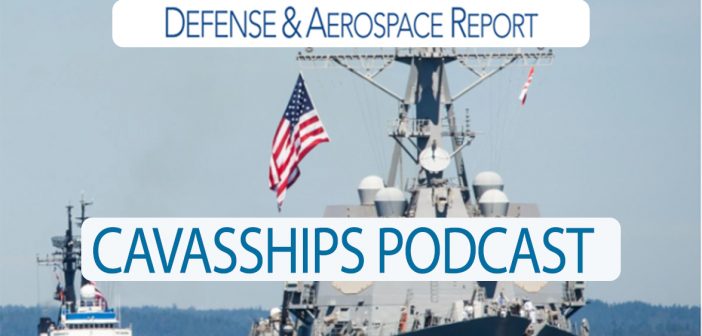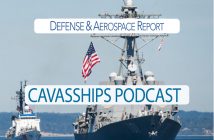Welcome to the CavasShips Podcast with Christopher P. Cavas and Chris Servello…a weekly podcast looking at naval and maritime events and issues of the day – in the US, across the seas and around the world. On this episode…Heritage Foundation’s Brent Sadler joins us to discuss shipbuilding, shipping, DOGE and recent activities in Indo-Pacom.
Please send us feedback by DM’ing @CavasShips or @CSSProvision or you can email chriscavas@gmail.com or cservello@defaeroreport.com.
This Week’s Naval News:
The deployed aircraft carrier USS HARRY S TRUMAN was in collision late on the evening of February 12th with a large merchant ship, the US Navy confirmed. The carrier, apparently preparing to pass southbound through the Suez Canal, collided with the fifty-three-thousand-deadweight ton bulker BESIKTAS-M (Buh-SHIKH-tas) in heavy ship traffic off Port Said, Egypt. While no injuries were reported, the US Navy released a photo February 14 showing structural damage to a crane sponson on the carrier’s starboard quarter, and USNI News reported the ship’s hull sustained further damage above the waterline. Photos of the BESIKTAS-M show minor damage to fittings on the bulker’s port bow. The Navy released few details about the incident, but from the damage visible in the photos, it appears the TRUMAN might have been crossing port to starboard when the collision took place. The carrier was expected to proceed to port for further damage assessment. Although registered in Panama, the BESIKTAS-M, built in 2005, is operated by Singapore-based United Ocean Management and reportedly owned in Turkey. TRUMAN deployed from Norfolk, Virginia, last September. In general, collisions between US aircraft carriers and merchant ships are extremely rare.
A US Navy EA-18G Growler electronic warfare aircraft from the Black Ravens of Electronic Attack Squadron 13 crashed into San Diego Bay on the morning of February 12 after the two-person crew safely ejected. The aircraft, normally based at Naval Air Station Whidbey Island in Washington State, was in San Diego for an exercise. It is not yet clear what inflight emergency led to the incident. VAQ-135 is an expeditionary squadron that deploys worldwide but normally does not operate from aircraft carriers. The crash took place during bad weather in San Diego which was hampering immediate efforts to recover the aircraft.
The destroyer USS RALPH JOHNSON with the US Navy survey ship BOWDITCH carried out a southbound transit of the Taiwan Strait from February 10th to the 12th, marking the first US Navy freedom of navigation passage through the strategic waterway between Taiwan and the Chinese mainland under the Trump administration. Reverting to form from the first Trump term, the US made no public announcement of the transit, which was reported by Chinese media. A spokesman for China’s Eastern Theater Command said the Chinese Navy and Air Force, quote, “effectively managed the situation.” US warships carried out at least five such transits during 2024.
Meanwhile, the Australian Ministry of Defence said that a Chinese Air Force J-16 fighter aircraft carried out quote an unsafe and unprofessional interaction” with an Australian Air Force P-8A Poseidon maritime patrol aircraft operating over the South China Sea. Australia said the Chinese fighter released flares in close proximity to the P-8, which, the Australians said, was operating in international air space.
The amphibious assault ship USS TRIPOLI will shift homeport to Sasebo, Japan from San Diego during 2025 and swap homeports with sistership USS AMERICA, the US Navy announced February 13. AMERICA has been based in Sasebo with the US Navy’s Forward-Deployed Naval Forces Japan since late 2019. Both ships are optimized to operate Marine Corps aircraft, including the F-35B short-takeoff version of the Lightning II Joint Strike Fighter. AMERICA currently is on patrol in the western Pacific with elements of the 31st Marine Expeditionary Unit.
In the Middle East, the International Maritime Exercise 2025, or IMX 25, began February 10th in waters off Bahrain and Jordan. The largest regularly-scheduled maritime exercise in the region involves more than 5,000 personnel from over 35 nations in multiple exercises in the Persian Gulf and Gulf of Aqaba, hosted by US Naval Forces Central Command. And later this year, US naval forces in the region will be bolstered by the transfer of three San Diego-based littoral combat ships, the CANBERRA, SANTA BARBARA and TULSA, to operate from Bahrain.
Servello Squawk:
As we briefly discussed in the last segment, the DOGE team will soon turn its attention to the Department of Defense to identify inefficiencies and waste within the services. The goal of this effort is to both better use appropriated funds and to save taxpayers money by trimming the fat.
This is a generational opportunity to cut programs to nowhere, shed unnecessary staff and kill outdated contracts, while doubling down on force structure and technology needed to stay ahead of our competitors.
Undoubtedly loyal, hardworking civilian and contractor employees will lose their jobs because the services they provide will be deemed out of date or no longer required. For that I am very truly sorry.
No one wants to lose their job, no one wants to be told they aren’t needed anymore. I remember when Navy leadership fired 3000 sailors in 2012 through the Enlisted Retention Board effort. The scars of that initiative lasted years because of how badly it was handled. I hope the same mistakes won’t be made this time around.
Despite that possibility, I truly believe the DOGE work is necessary. There is so much wasted time and money accepted in how the Pentagon does business. And while I believe a bigger and more capable force is needed, Im not sure simply spending more money is the answer.
Before we consider growing, we must prune the excess, the ineffective and the unnecessary.
It’s time to get rid of useless butts-in-seats programs that don’t advance lethality, recruiting or retention, to say nothing of the Navy’s ability to prevent and win conflicts.
It’s unconscionable that our acquisition systems still have not delivered our Sailors modern pay, personnel, and learning systems despite squandering billions of dollars and even more hours on failed IT. Why do we prop-up a bureaucracy that makes it harder and longer to build and fix ships instead of stream-lining the process.
Efforts that actually deliver more force structure, greater repair capability, newer weapons, badly needed data science and software investments, along with operational Sailors must be protected and grown. Pet projects and ineffective in-house efforts that don’t send a clear message to the Russians and Chinese that we are serious must go. It’s that simple.
As Navy leadership leans into DOGE I hope they won’t treat this like just like any other budget drill. Simply searching for the biggest and shiniest object to cut in order to meet a top line number won’t be sufficient.
It’s critical that the Secretariat and the OPNAV staffs really know what type of Navy we need and help DOGE remove the obstacles to getting there. Please, let’s not mess this up.



